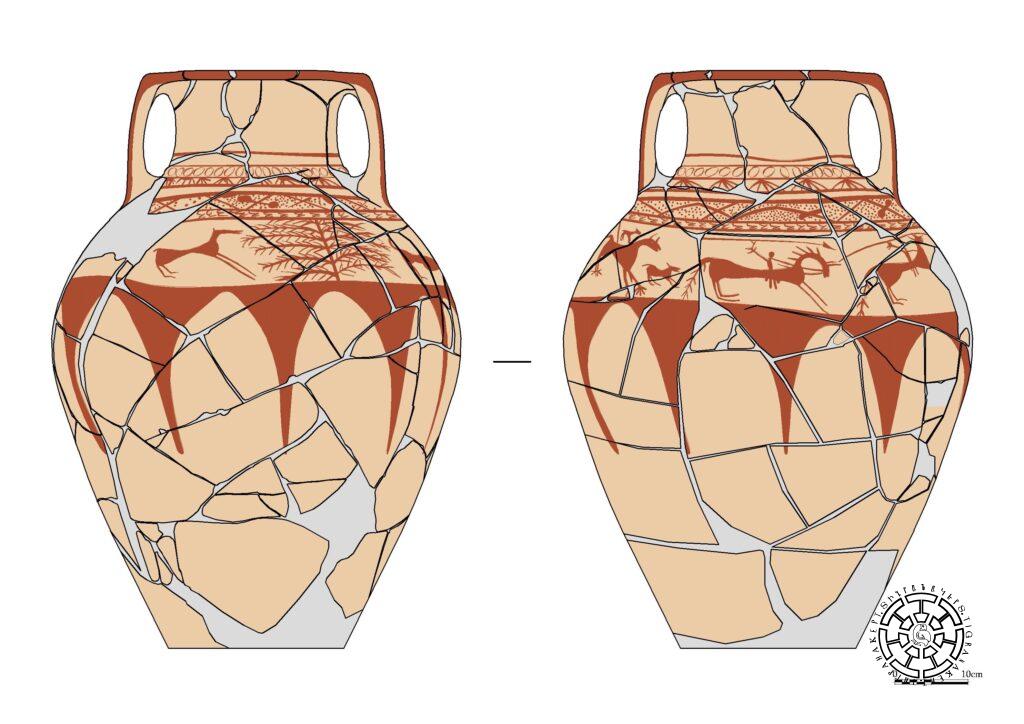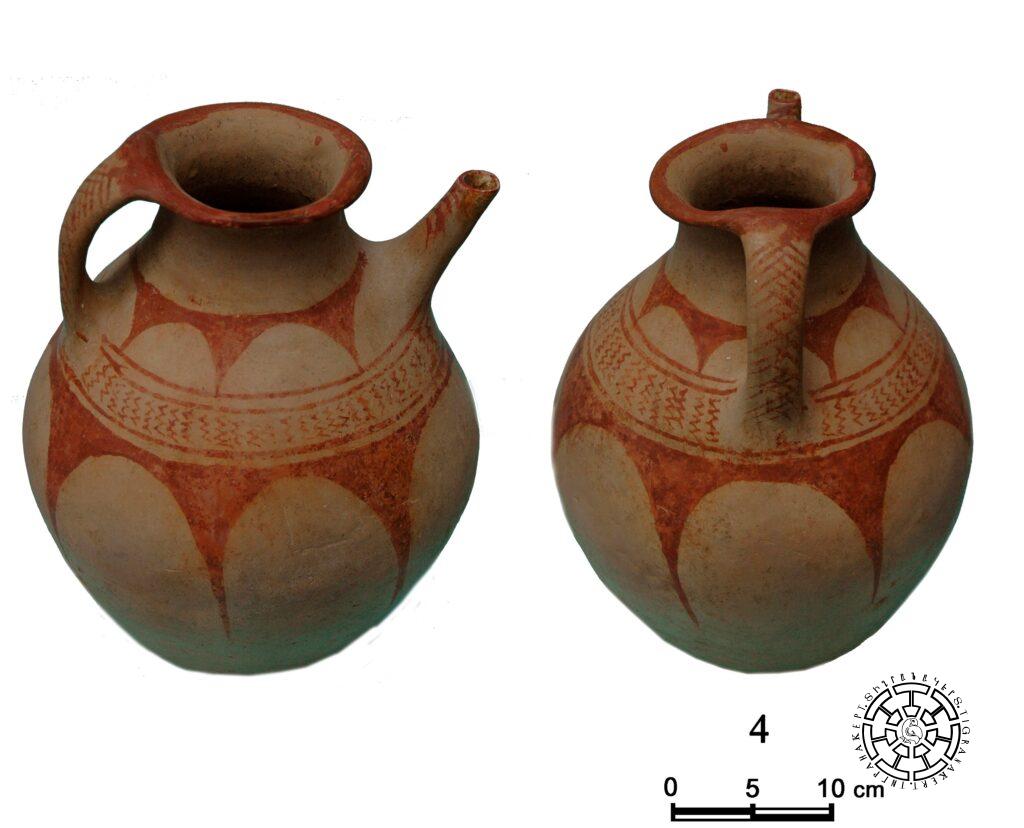Antique pottery
The excavations of Tigranakert in Artsakh revealed a number of archeological complexes of the late Hellenistic and late antique periods (1st century BC-3rd century AD) where pottery occupies a unique place and is the most abundant archeological material of more than a decade-and-a-half of excavation. The antique pottery with its types and forms is noticeable for its great diversity: jars in different measurements, clay pots, single-handle, double-handle, and spouted jugs, flasks, churns, small pots, tubs, bowls, hemispheric and semi-oval goblets, trays, plates, fish plates, oil lamps, etc. According to the application, they are divided into groups: construction, preservation, and reproduction of food, kitchen purposes, tableware, commercial travel; and ritual worship. These groups, in turn, are divided based on their morphological features, into classes, types, and options.
The clay jars were designed to store wine, grain, and other “flowing” foods. Typically, colored jars with rich decorative designs were utilized for serving drinks during ceremonial occasions. Household jars were often used for the burial ritual, known as pithos burials, in Armenia and in its neighboring countries, serving as burial vessels.
In 2018, a beautifully colored jar with handle was excavated in the eastern cemetery of Tigranakert (Fig. 1). The surfaces of the handles and rim of the jar were painted red; the junction of the neck and body featured two red lines and a convex band decorated with finger impressions. From the crown of the vessel to the widest part of the body, there are several bands illustrated. The upper ones are covered with ornamental bands, the middle one with a figurative composition, and the lower one with an arcade design. The widest band depicts a deer hunting scene. The scene unfolds on both sides of a tree with scattered branches: foot and mounted hunters armed with spears, arrows, and bows, accompanied by dogs, pursue roe deer.

Another smaller colored jar was found in Martakert in 2013. The light yellowish-cinnamon convex body of the vessel, which is complete up to the neck, is adorned with two successive decorative bands, the first of which represents a rhythmic alternation of humans and deer (Fig. 2). At the end of the nine-animal row are depicted two human figures (pagan priests?) in a long, up-to-the-shins robe (Fig. 2). The skirts of the latter’s clothes are cut, under which the bare legs of the personages are visible. Below that, the next band consists of the interlined triangles pointed upwards in red, as if they depict a mountainous landscape, adding even more mystery to the scene of the ritual procession.

Jugs, which are tableware, form a large group among antique pottery. They have a flat seat, at the bottom spherical and at the top convex body, a high crown with a long neck. The jars are made of fine-grained, well-kneaded clay that has turned a light yellow-brown after burning. The exterior is well smoothed, polished, and normally colored. The vessels with a convex body, a short neck, a clover-shaped lip, and a bow-shaped handle, one end of which is adjacent to the lip and the other to the shoulder, form a separate group.
The excavations in Tigranakert and randomly found spouted jugs from the region (Martakert and Varanda of the Hadrut region) are almost identical in terms of morphological and metrical data. They are vessels with a flat seat, a spherical (slightly biconic) body, a neck that gradually narrows towards the lip, a bulging lip that protrudes outward, a spout, and a handle fixed to the opposite side of the spout (Fig. 3). The surface of the jars is well-smoothed, polished, and colored. The edge of the trumpet-shaped lip is made up in red paint, and the spout and the oval-shaped handle in the cut are formed with italic and intersecting dashes. Most likely, the spouted jugs were used to serve drinks, as evidenced by the high artistic quality and luxurious decoration of these vessels.
The clay jugs have some basic generalities in shape: a wide and flat seat, upwardly expanding walls, a convex body, a short-inflected neck, and a wide mouth with an outwardly bulging or straight lip. The jugs used in tableware are made of clean, fine-grained, sometimes sandy clay and are generally well crafted. The outer surface is coated with a reddish-brown, yellowish-brown, and pink paste that is finely polished. The lips of some of the vessels are painted with red lines or covered with thick lines of brown paint, and the outer surface is decorated with colors or engravings. The jugs are presented in no-handle (Fig. 4) or double-handle versions.
The best complete example of a double-handle jug used in tableware is a wide-lip vessel with a flat bottom, a slightly biconical body, and a short neck, the handles of which descend from the lip to rest on the broad part of the body. With a light reddish-pink exterior, the whole vessel, including the handles, is decorated with motifs of dark, warm red paint. In this group of tableware can be included the dark gray, well-polished, double-handle jug found in the Antique Quarter, the handles of which descend from the lip of the vessel to the shoulder, have an inward curve passing from the center, and upper ball-buttons on the lips.
The Tigranakert bowls are open vessels with a flat seat and from the bottom upwardly widening sides, which, despite their variety, have a stable format mainly differing in the shape of the crown. According to the shape of the crown, they are generally shaped with an outwardly or inwardly inclined lip.
The most common in this series are the bowls with an outwardly inclined lip, with a slightly bulging lip joining the side of the vessel, or with either a straight or inch inflection or a smooth or sharp edge, giving rise to a few variants. The bowls found in Tigranakert are mostly made of high-quality, well-kneaded clay, fired evenly. The lips of the bowls are decorated with oblique dashes of various hues of red on a light base paint; the inner surface is sometimes decorated with several parallel concentric circles made of reddish-pink paint.
The clay flasks are extremely unique vessels characterized by a disc-shaped body, often convex on both sides, sometimes convex on one side and flat-cut on the other, a short neck terminating in a round lip, and two small handles fixed on narrow sides. They are crafted from well-kneaded clay containing a finely ground calcareous mixture. The outer surface is coated with a yellowish-brown and pink ointment, meticulously trimmed and polished. The convex side of the clay flasks is adorned with concentric bands painted in various shades of red and dark cinnamon, and the center of the vessel typically features a cross, rays radiating from the center, or a vegetal pattern. In antiquity, these vessels served as essential containers for transporting food such as beverages and oil for commercial and traveling purposes.

The artistic decoration of antique pottery
Apart from the variety of forms, the antique pottery of Tigranakert stands out for its wealth of finishing techniques, decorative motifs, and compositions, appearing in luxuriously colored black and gray, polished, stamped, and carved types.
Among them, the colorful assortment stands out for its abundance. The illustrations of the clay pots were mainly made with single-color paints, although there are also two-color examples made with black and red. The palette used is diverse and presented in various shades of ocher, from pink to red, from light brown to deep dark, and rarely black. The placement of the ornament on the surface of the vessel is dictated primarily by the shape of the vessel. In the case of closed vessels, it is inserted mainly on the upper part—the lip, neck, handles, and the widest part of the body. In the case of clay flasks, the ornament occupies the convex side of the vessel (ventricle). In the case of open vessels (bowls, goblets, plates, and trays), both the outer and inner surfaces of the vessels are illustrated. Thus, there is an immediate connection between the shape of the vessel and the ornamentation.

The decorative motifs and images are varied: geometric, floral, and figurative.
Among the geometric ornaments popular and widely used by Tigranakert craftsmen are the horizontal bold lines encircling the vessel, small angles directed to the right or left, reticulated zones, inscribed triangles, bold triangles, vertical and horizontal wavy lines, chains, spirals, etc. In the artistic decoration of the clay pots, vegetal patterns are less common and are represented mainly by fir-shaped and spike-like motifs. Figurative images are mainly found in hunting scenes and compositions with ritual themes.
Among the antique pottery of Tigranakert, although small in number, the vessels decorated by the stamping method form a unique group. Exceptional examples of stamp-decorated pottery are the more than three dozen sherds of bowls decorated with internal bands of clusters excavated in the Fortified and Antique Quarters. The conical, with a sharp top, downward-pointing, round ball-filled stamped images on these vessels most likely depict a bunch of grapes.
Exceptionally, the open vessels intended for drinking liquid or wine were stamped with clusters. The goblets and bowls bearing bunches of grapes are evidence that winemaking was developed in Tigranakert in ancient times.
In ancient Armenian monuments, except for Tigranakert, there are still no vessels carrying clusters. This fact, as well as the already indicated variety of Tigranakert vessels, allows us to consider the above-mentioned shiny black vessels to be the product of Tigranakert. The diversity of the morphological and decorative adornment of the antique pottery of Tigranakert and its special image, which is characteristic of the right bank of the Kur River, give an opportunity to talk about the cultural phenomenon of Tigranakert. It once again confirms that the city was the major commercial, craft, and cultural center of Artsakh-Utik and the transmitter of cultural values to the north and east in the ancient period.